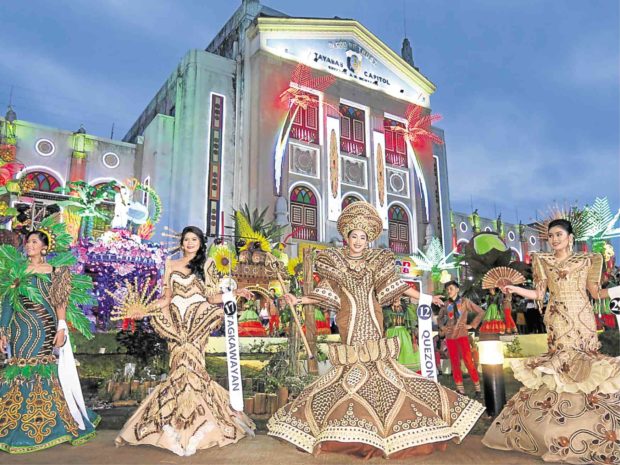
COCO BEAUTIES Muses representing Quezon towns wear coconut-inspired costumes. —DELFIN T. MALLARI JR.
LUCENA CITY — It’s that time of the year when the largely agricultural province of Quezon highlights its top product through a coconut-themed festival.
The Niyogyugan Festival is on its seventh staging in this provincial capital this year, but visitors have noticed a vast improvement on the design of coconut-inspired booths representing different towns.
“I’ve witnessed and enjoyed [the] festival [since 2012]. I’m proud that the booth designs this year have all greatly improved. They reflect the inherent artistry of the Quezonian,” said Aristeo Manalo, a retired government employee and resident of this city.
Tree of life
“Looking back … we’re really progressing and developing. The booths are now more creative, more inspiring with their intricate designs,” said Gov. David Suarez.
The festival, first held in 2012, was conceptualized by the governor’s mother, then Quezon Rep. Aleta Suarez, to give tribute to the coconut, also known as the “tree of life.” The event aims to contribute to the cultural and historical development of the province, and also to promote tourism and locally produced coconut products.
The event was canceled in 2014 after Typhoon “Glenda” (international name: Rammasun) devastated coconut farms in the province.
“Niyogyugan” is derived from “niyog” (coconut) and “yugyog” (to shake or dance). Thirty-seven of Quezon’s 39 towns and two cities are participating in this year’s festival, up from the initial 20 towns that joined its first staging. The towns of San Narciso and San Francisco did not join this year.
Other festival events are the commemoration of the birth of former President Manuel L. Quezon on Aug. 19 and the awarding of the Quezon Medalya ng Karangalan to the province’s outstanding citizens on Aug. 16.
The booths, all made from parts of the coconut tree, depict the unique character of the towns, local culture and their people.
The booth of Catanauan depicts a coconut farmer with a basket full of coconuts on his sled. Hanging from its ceiling is a chandelier made from coconut shells and capiz shells that symbolizes the coastal town’s rich marine resources.
NATIVE PRODUCTS Mauban’s booth, which sells native products, is made to appear like a “buko,” or young coconut.
The seahorse and seaweed design of Polilio’s booth is perfect as backdrop for selfies while Infanta’s booth is highlighted by a replica of a cracked giant coconut on its roof.
Farm tourism
Tourism Undersecretary Arturo Boncato Jr. hailed Niyogyugan as an example of a sustainable tourism program.
“We see Quezon as a perfect example of a local government unit that has been doing it early on even without stating it as a matter of policy,” said Boncato, who represented Tourism Secretary Bernadette Romulo-Puyat during the festival’s opening last week.
Boncato said the festival complements the Department of Tourism’s (DOT) farm tourism program. He said the DOT had already accredited six farm tourism sites in Quezon.